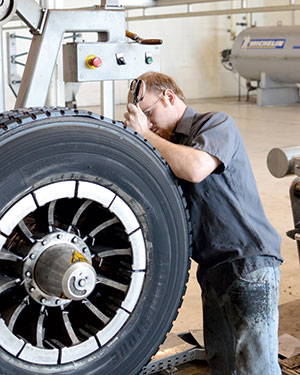Special to Transport Topics
Retread Industry Feels Pinch From Tire Imports
Low-cost truck tire imports, particularly those from China, have cut into domestic new-tire sales over the past five years. But they’ve had an even more dramatic effect on the U.S. retread tire industry.
Due to many Asian imports coming into the market that can compete with the cost of retreads, “over the last two years, we’re seeing a huge drop in semi tires being retreaded,” said Gary Champlin, general manager of Kansas-based Champlin Tire Recycling.
He estimates that, nationally, retreading is down 20-25% over the last two years. “In our shop, it’s even greater than that,” Champlin said.

A pre-cured retread is applied to a tire casing. (TT File Photo)
Low-cost, new-tire imports provide carriers with a price that averages one-third to one-half the cost of premium tires, which puts them squarely in the retread price range.
“The price of these Chinese tires is even less than the price of retreaded premium and budget tires,” said Marshall Martin, senior research analyst for automotive and transportation at Frost & Sullivan.
Pennsylvania-based PGT Trucking, which occasionally uses retreads on its tandem-axle trailers, recently was approached by a salesperson for a Chinese company new to the U.S. market. PGT was offered “a brand new virgin tire pretty much at the same price as a recap,” said Larry Cox, director of process improvement.
Initially, the offer seemed appealing, but Cox found holes in the company’s business model and reverted to his belief about tire quality. “Buying ‘cheap tires’ is not in our [best] interest,” he said.
Cox said that buying quality tires — either new or retreaded — from a reputable distributor means that a customer is buying product and service, and is supported by nationwide networks of repair shops, distributors and road service assistance. “That service is important to a trucking company,” he said.
Meanwhile, the retread industry has fought negative perceptions that have carried over from quality concerns in decades past. Largely, it has overcome those perceptions and the operational and manufacturing issues that caused them, as evidenced by the growing number of fleets that use retreads on at least some of their trucks. The negative perceptions of quality, in many instances, now have shifted to the low-cost new tires manufactured by China-based companies.
The boom of low-cost Chinese tires in the U.S. market a few years ago impacted the retread industry, “as fleets would prefer going for a cheap new Chinese tire over retreading an old one,” Martin said. But in recent months, that practice “has lost some of its sheen due to negative feedback, largely due to poor quality.”
Besides quality, some fleets and retreaders alike question the environmental soundness of the low-cost new market entrants.
“Truck tires that aren’t retreadable impact our environment by going to landfills immediately after they are worn out, rather than extending their life through the possibility of multiple retreads,” Michelin’s Adam Murphy said. The average premium tire’s casing can be safely retreaded two to three times.
In addition, research from tire manufacturers’ retread divisions indicate that a number of new market entrants from Asia appear not to adequately meet U.S. environmental standards for tires.
With low-cost imports’ effect on the new-tire industry leveling a bit in recent months, analysts are watching for long-term trends there and on retreads. The U.S. International Trade Commission’s decision last year not to impose tariffs on Chinese tire imports is a prime factor expected to influence both markets in 2018.
It will make the new tire market more competitive “and be a threat to the already declining retreading business,” Martin said.

